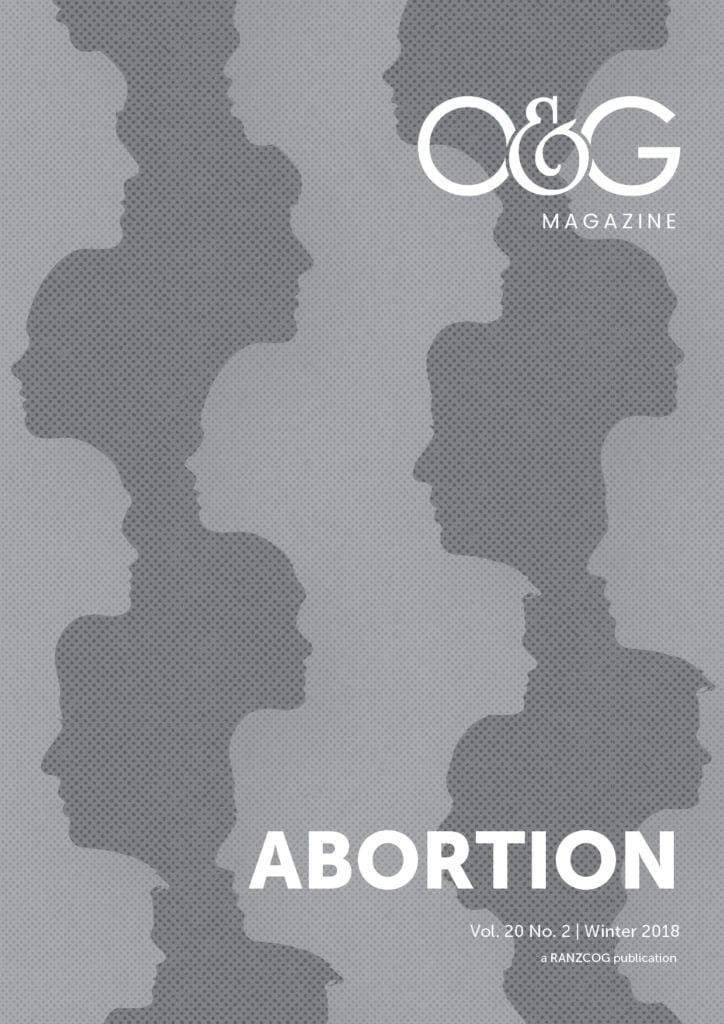Provision of effective reversible contraception following abortion is recognised by the World Health Organization1 as a key component of integrated care. Given that ovulation can occur as soon as eight days after an abortion2 3 and more than 50 per cent of women have been reported to resume sexual activity within two weeks after an abortion,4 early initiation of an effective contraceptive method is essential. Ideally, all women should receive information about, and be offered, effective contraception as part of their care, as delayed provision has been shown to be associated with a higher risk of a repeat unintended pregnancy.5 6 7 8 9 Available data in Australia indicate that 36.6 per cent of women having an abortion have had a previous termination.10 Studies from the UK11 12 13 report that women value the opportunity to discuss contraception and to be offered their chosen method. In this article, we review the range of contraceptive methods which can be provided after a surgical or medical abortion.
Supporting contraceptive choice
Australian data suggest that more than 50 per cent of women presenting for an abortion were using a contraceptive method at the time of conception, with condoms and the oral contraceptive pill being the most common methods reported.14 15 An important component of the abortion consultation is a discussion about contraception, including prior contraception use. Information should be provided about the higher relative efficacy of long-acting reversible contraception (LARC), including implants and intrauterine methods, compared to user-dependent, shorter-acting methods such as the contraceptive pill. Permanent sterilisation methods are generally not recommended at the time of termination, as this may be associated with a higher chance of regret.16
Contraceptive options after surgical and medical abortion
The medical eligibility criteria from both the World Health Organization17 and the Faculty of Sexual and Reproductive Healthcare18 in the UK support the immediate provision of all contraceptive methods after abortion, unless there are medical contraindications for an individual woman. With the exception of intrauterine contraception after a medical termination, contraception can potentially be provided on the same day as a first or second trimester surgical abortion and at the time of prescribing and/or taking mifepristone for a medical abortion.
Hormonal contraception, if initiated within the first five days after a medical or surgical abortion, is immediately effective. Copper-bearing intrauterine devices (Cu-IUDs) are effective immediately when inserted any time after an abortion. Delaying initiation until a later time, including a delay while waiting for a menstrual period to occur, may increase the risk of a rapid repeat unintended pregnancy.
Contraceptive implants
The contraceptive implant can be inserted under the skin of the upper inner arm at the time of a surgical termination. Initiation of these progestogen-releasing devices at the time of mifepristone does not appear to reduce the effectiveness of medical abortion19 and insertion can occur at the time of prescribing and/or taking mifepristone.
When the implant is inserted within the first five days following a surgical or medical abortion, it will be immediately effective. Alternatively, the implant can be inserted during days one to five of the menstrual cycle with immediate effectiveness, or at any other time using the Quick Start method,20 even if an undetectable early pregnancy cannot be excluded. In this Quick Start scenario, the woman must understand the need for seven days of abstinence or the consistent use of condoms while waiting for the implant to become effective, as well as the necessity for a follow-up pregnancy test. There is no current evidence to suggest that the bleeding pattern is any different when the implant is inserted at the time of abortion compared to the pattern experienced when it is inserted at other times.
Intrauterine contraception
Intrauterine contraception (IUC) can be inserted at the time of surgical abortion or as soon as expulsion of the products of conception has been confirmed after medical abortion.21
Insertion of IUC at the time of abortion is convenient and highly acceptable to women. Clinical guidelines22 23 24 recommend the immediate insertion of an IUC following surgical abortion at any gestation. There is no increased risk of complications, such as infection or bleeding, for immediate versus delayed insertion of an IUC. There are fewer bleeding problems with immediate insertion of a levonorgestrel-releasing intrauterine system (LNG-IUS) following surgical abortion than following menses. There is some evidence that expulsion may be greater with an IUC inserted following a second-trimester abortion than following a first-trimester abortion. Immediate insertion is associated with higher continuation rates and a reduced risk of repeat unintended pregnancy than when insertion is delayed.25 26
Although it is necessary to delay IUC until after confirmation of the expulsion of products of conception, there is no need to routinely wait until the next menses.27 IUC can be inserted safely at any time after expulsion of the products of conception and the use of ultrasound prior to insertion to exclude an ongoing pregnancy can be helpful. There appears to be no difference in complication rates between insertions conducted within one week of taking mifepristone or two to three weeks later.28
However, IUC insertion for a woman diagnosed with infection following abortion follows the same principles as for any pelvic infection and must be delayed until there has been complete resolution of symptoms.
The Cu-IUD is immediately effective from insertion, while the LNG-IUS is only immediately effective if inserted within the first five days after a surgical or medical abortion, or during the first seven days of the menstrual cycle. If the LNG-IUS is inserted at any other time it will take seven days to become effective, during which time condoms or abstinence will be needed.
Injectable DMPA
Depot medroxyprogesterone acetate (DMPA) injections remain a valuable method of contraception for some women and can also be a useful method of bridging contraception following abortion prior to an implant or IUC. An injection can be administered at the time of a surgical abortion and will provide effective contraception for up to 14 weeks. In the context of medical abortion, there is some concern that initiation of DMPA at the time of mifepristone administration may impair the progesterone-blocking action of mifepristone, reducing medical abortion efficacy.29
Women having a medical abortion should therefore be advised that there may be a slightly higher risk of continuing pregnancy if DMPA is initiated at the time of mifepristone administration. The risks versus the benefits should be discussed on a case-by-case basis. Women choosing to start DMPA at this time need careful follow-up to exclude an ongoing pregnancy.
Combined hormonal pill
The combined hormonal pill can be initiated on the day of a surgical abortion, although in practice, this usually occurs the next day. For medical abortion, the usual recommendation is to commence the day after misoprostol administration. Provided that pill-taking has commenced within five days of medical or surgical abortion, it will be effective immediately.
Vaginal ring
Although most providers recommend against inserting anything in the vagina during the first week post-abortion, there is little evidence to support this restriction. The vaginal ring can be inserted as early as one day after surgical abortion or misoprostol administration, although waiting two to three days may be preferred for women with heavy bleeding.30 31
Progestogen-only pills (POPs)
In Australia, only low-dose levonorgestrel or norethisterone POPs are available, which must be taken within a three-hour time frame each day. This narrow window can make POPs less effective than other methods, although the higher dose desogestrel POP available in New Zealand, which has a 12-hour time frame due to its effect as a reliable anovulant, can be a useful option for women who have contraindications to oestrogen. As with the combined pill, the POP should be commenced immediately, or within five days, after surgical or medical abortion.
Barrier methods
Condoms, either male or female types, can be used immediately after an abortion. Women at risk of STIs can be advised to use condoms at the same time as other more effective methods of contraception. The relatively high failure rate of the diaphragm limits its use for women wanting to prevent pregnancy. It can be used as soon as required after a first-trimester abortion, but should be delayed until six weeks after a second-trimester abortion.32
Fertility awareness methods
Although fertility awareness methods can be effective when used diligently and correctly, extreme caution is required shortly after abortion when signs of fertility may be disrupted. Any calendar-based method cannot be relied upon until at least one menstrual period has occurred.33
Emergency contraception
There are two types of single-dose emergency contraceptive (EC) pills available without a prescription at pharmacies: the 1.5mg levonorgestrel (LNG-EC) pill or the 30mg ulipristal acetate pill licensed for use up to three or five days respectively after unprotected intercourse. Both act by delaying or preventing ovulation and are most effective when taken as soon as possible. Women should be made aware of EC pill availability and should be offered emergency contraception for any unprotected sex34 from five days after an abortion. Services could potentially provide women with an advanced supply of an EC pill if clinically appropriate. A Cu-IUD can also be used within five days of unprotected intercourse as a method of emergency contraception, which also provides highly effective ongoing contraception for up to 10 years.
Conclusion
Promotion and provision of effective contraception after abortion is essential to prevent repeat unintended pregnancies and should ideally be integrated within services. The most effective long-acting reversible contraceptive (LARC) methods, namely the implants and IUC, can be provided immediately following abortion. However, if this is not feasible, or if the woman prefers to go back to her GP or a family planning service for contraception, a short-term bridging method should be advised with information provided about the availability of emergency contraception.
References
- World Health Organization. Safe abortions: technical and policy guidance for health systems: World Health Organization; 2012.
- Gemzell-Danielsson K, Kallner HK. Post-abortion contraception. Women’s Health 2015;11(6):779-84. doi: 10.2217/whe.15.72.
- Schreiber CA, Sober S, Ratcliffe S, Creinin MD. Ovulation resumption after medical abortion with mifepristone and misoprostol. Contraception 2011;84(3):230-3. doi: 10.1016/j.contraception.2011.01.013.
- Boesen HC, Rørbye C, Nørgaard M, Nilas L. Sexual behavior during the first eight weeks after legal termination of pregnancy. Acta Obstetricia et Gynecologica Scandinavica 2004;83(12):1189-92. doi: 10.1111/j.0001-6349.2004.00494.x.
- Rose SB, Lawton BA. Impact of long-acting reversible contraception on return for repeat abortion. American Journal of Obstetrics & Gynecology 2012;206(1):37. e1-. e6. doi: 10.1016/j.ajog.2011.06.102.
- Goodman S, Hendlish SK, Reeves MF, Foster-Rosales A. Impact of immediate postabortal insertion of intrauterine contraception on repeat abortion. Contraception 2008;78(2):143-8. doi: 10.1016/j.contraception.2008.03.003.
- Reeves MF, Smith KJ, Creinin MD. Contraceptive effectiveness of immediate compared with delayed insertion of intrauterine devices after abortion: a decision analysis. Obstetrics & Gynecology 2007;109(6):1286-94. doi: 10.1097/01.AOG.0000265336.14160.cc.
- Raymond EG, Weaver MA, Tan Y-L, Louie KS, Bousiéguez M, Lugo-Hernández EM, et al. Effect of immediate compared with delayed insertion of etonogestrel implants on medical abortion efficacy and repeat pregnancy: a randomized controlled trial. Obstetrics & Gynecology 2016;127(2):306-12. doi: 10.1097/AOG.0000000000001274.
- Hognert H, Kopp Kallner H, Cameron S, Nyrelli C, Jawad I, Heller R, et al. Immediate versus delayed insertion of an etonogestrel releasing implant at medical abortion – a randomized controlled equivalence trial. Human Reproduction 2016;31(11):2484 90. doi: 10.1093/humrep/dew238.
- Scheil W, Jolly K, Scott J, Catcheside B, Sage L, Kennare R. Pregnancy Outcome in South Australia 2015. Adelaide: Pregnancy Outcome Unit, SA Health, Government of South Australia; 2017.
- Cameron ST, Glasier A, Johnstone A. Shifting abortion care from a hospital to a community sexual and reproductive health care setting. Journal of Family Planning and Reproductive Health Care 2016;42(2):127-32. doi: 10.1136/jfprhc-2015-101177.
- Purcell C, Cameron S, Lawton J, Glasier A, Harden J. Contraceptive care at the time of medical abortion: experiences of women and health professionals in a hospital or community sexual and reproductive health context. Contraception 2016;93(2):170-7. doi: 10.1016/j.contraception.2015.09.016.
- Faculty of Sexual & Reproductive Healthcare, RCOG. FSRH Guideline Contraception After Pregnancy. UK: Faculty of Sexual & Reproductive Healthcare; 2017.
- Marie Stopes International. Real Choices: Women, Contraception and Unplanned Pregnancy. Marie Stopes International; 2008.
- Weisberg E, Goldstone P, Heckenberg M, Stewart M. A profile of women terminating pregnancies in NSW. First National Sexual & Reproductive Health Conference; Melbourne: Public Health Association Australia; 2012.
- Family Planning NSW, Family Planning Victoria, True Relationships and Reproductive Health. Contraception: An Australian clinical practice handbook – 4th edition. Ashfield NSW 2016.
- World Health Organization. Medical eligibility criteria for contraceptive use – 5th edition: World Health Organization; 2015.
- Faculty of Sexual & Reproductive Healthcare, RCOG. FSRH Guideline Contraception After Pregnancy. UK: Faculty of Sexual & Reproductive Healthcare; 2017.
- Hognert H, Kopp Kallner H, Cameron S, Nyrelli C, Jawad I, Heller R, et al. Immediate versus delayed insertion of an etonogestrel releasing implant at medical abortion – a randomized controlled equivalence trial. Human Reproduction 2016;31(11):2484 90. doi: 10.1093/humrep/dew238.
- Faculty of Sexual & Reproductive Healthcare. FSRH Guideline Quick Starting Contraception. UK: Faculty of Sexual & Reproductive Healthcare; 2017.
- Gemzell-Danielsson K, Kopp Kallner H, Faúndes A. Contraception following abortion and the treatment of incomplete abortion. International Journal of Gynecology & Obstetrics 2014;126:s52-s5. doi: 10.1016/j.ijgo.2014.03.003.
- Faculty of Sexual & Reproductive Healthcare, RCOG. FSRH Guideline Contraception After Pregnancy. UK: Faculty of Sexual & Reproductive Healthcare; 2017.
- RCOG. The care of women requesting induced abortion (Evidence-based Clinical Guideline No. 7): RCOG Press; 2011.
- Ipas. Clinical Updates in Reproductive Health. Brahmi D, editor. Chapel Hill, NC: Ipas; 2017.
- Gemzell-Danielsson K, Kopp Kallner H, Faúndes A. Contraception following abortion and the treatment of incomplete abortion. International Journal of Gynecology & Obstetrics 2014;126:s52-s5. doi: 10.1016/j.ijgo.2014.03.003.
- Cremer M, Bullard KA, Mosley RM, Weiselberg C, Molaei M, Lerner V, et al. Immediate vs delayed post-abortal copper T 380A IUD insertion in cases over 12 weeks of gestation. Contraception 2011;83(6):522-7. doi: 10.1016/j.contraception.2010.10.005.
- Sääv I, Stephansson O, Gemzell-Danielsson K. Early vs delayed insertion of intrauterine contraception after medical abortion — a randomized controlled trial. PLoS One. 2012;7(11):e48948. doi: 10.1371/journal.pone.0048948.
- Faculty of Sexual & Reproductive Healthcare, RCOG. FSRH Guideline Contraception After Pregnancy. UK: Faculty of Sexual & Reproductive Healthcare; 2017.
- Faculty of Sexual & Reproductive Healthcare, RCOG. FSRH Guideline Contraception After Pregnancy. UK: Faculty of Sexual & Reproductive Healthcare; 2017.
- Reproductive Health Access Network. Contraceptive Pearl: Starting the vaginal ring after abortion. 2015. Available from: www.reproductiveaccess.org/resource/contraceptive-pearl-starting-vaginal-ring-TOP/.
- Fine PM, Tryggestad J, Meyers NJ, Sangi-Haghpeykar H. Safety and acceptability with the use of a contraceptive vaginal ring after surgical or medical abortion. Contraception 2007;75(5):367-71. doi: 10.1016/j.contraception.2007.01.009.
- Faculty of Sexual & Reproductive Healthcare, RCOG. FSRH Guideline Contraception After Pregnancy. UK: Faculty of Sexual & Reproductive Healthcare; 2017.
- Faculty of Sexual & Reproductive Healthcare, RCOG. FSRH Guideline Contraception After Pregnancy. UK: Faculty of Sexual & Reproductive Healthcare; 2017.
- Faculty of Sexual & Reproductive Healthcare, RCOG. FSRH Guideline Contraception After Pregnancy. UK: Faculty of Sexual & Reproductive Healthcare; 2017.








Leave a Reply